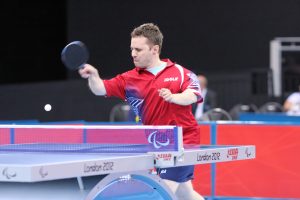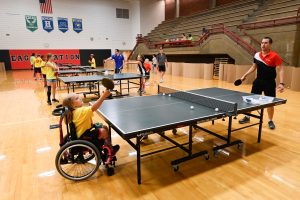Table Tennis
Para Table Tennis: From the Rec Room to the Paralympics
Table tennis is one of the most popular sports in the world with 16 million players in the U.S. alone. You can find table tennis in the basements and rec rooms of individual homes and apartments across the country. You can also play the game at sport and recreation facilities, university centers, and various other locations. So it is a relatively accessible game. It is also pretty fun. For some adaptive athletes, para table tennis can also be a pretty competitive sport. In fact, table tennis has been a Paralympic sport since the first games in 1960.
WHY Table Tennis?
 Besides it being an opportunity to get some good exercise and to stay healthy, Paralympic Gold Medalist Tahl Leibovitz, who will be playing in his sixth Paralympic Games in Tokyo, got into the sport as a youth at the South Queens Boys and Girls Club in order to make his reflexes faster. “As the ball comes towards you, you have to make a choice on what to do as soon as possible,” he said.
Besides it being an opportunity to get some good exercise and to stay healthy, Paralympic Gold Medalist Tahl Leibovitz, who will be playing in his sixth Paralympic Games in Tokyo, got into the sport as a youth at the South Queens Boys and Girls Club in order to make his reflexes faster. “As the ball comes towards you, you have to make a choice on what to do as soon as possible,” he said.
But Leibovitz, who equates the game of para table tennis as “running, playing chess, and boxing at the same time” also says there are other reasons to play. “The sport is almost psychotherapy. Also, it is great to see the different backgrounds coming together to play. And the sport is for all ages, as we have players in their 60s.”
For Team USA athlete Ian Seidenfeld, who is making his Paralympic debut in Tokyo and following in the footsteps of his father Mitchell (a Paralympic medalist and table tennis world champion), it is about the relationships that he has developed through the sport. “Friendships keep me coming out to play.” It is also different from a lot of other sports. “It is not as physical, as it is more of a technical and mental sport. It is all in the hands, particularly the wrists and fingers.”
REQUIRED Equipment
Table tennis is played in more than 220 countries and one of the most popular Paralympic sports internationally. For the most part, there are only three pieces of equipment that you need and all three can be commonly found at sporting goods stores and some department stores in your area.
The first, of course, is the table itself. The dimensions of an approved table tennis table are 9 feet long by 5 feet wide, and about 2 ½ feet high. The table includes a net that goes across the width in the middle of the table, dividing the table into two playing areas. The net sits 6 inches high.
 A table tennis racket is also required, with one side being black and the other side being red or another approved color. The racket, or paddle, has a wood blade with rubber affixed on each side.
A table tennis racket is also required, with one side being black and the other side being red or another approved color. The racket, or paddle, has a wood blade with rubber affixed on each side.
The only other item you need in order to play the game is an officially approved ball, which is plastic and about 40 millimeters in diameter.
In terms of equipment, the table is typically the most expensive purchase if you wanted to have your own for practice. If you want to just give the sport a try, most facilities and locations will have program equipment you can use. Beginner rackets are inexpensive. If you decide to get serious and start competing, then you might consider purchasing better equipment at that time. “Rackets can cost up to $250, but it could take years before you need to make that investment,” Seidenfeld said.
ADAPTATIONS
Table tennis can be played by individuals with various disabilities. At the Paralympic level, there are 11 different classifications currently, including wheelchair (classes 1-5), ambulatory/standing (classes 6-10), and intellectual impairment (class 11). The lower the number within the wheelchair and standing categories, the more potential the impairment may impact the athlete’s ability to compete.
PLAYING The Game
Games, or matches, are typically played as the best of five sets. Each set goes to 11 points and the winner must win by 2 points.
 Each player serves twice and then the serve rotates to the opponent. Points can be awarded by either player during the serve (versus only points being awarded off their own serve).
Each player serves twice and then the serve rotates to the opponent. Points can be awarded by either player during the serve (versus only points being awarded off their own serve).
In para table tennis, basic rules regarding equipment, process, and scoring are the same as the able-bodied version of the sport. However, there may be some exceptions regarding the serve in some classifications.
There are different ways to score points, including when the ball goes off the table or when it hits the net but doesn’t go over to the other side. Each player tries to find the weakness of their opponent.
During the serve, if the ball hits the net it is a redo. For a legal serve, you must throw the ball straight up at least six inches high and from a flat palm. The toss and contact must take place from behind the table and the ball must be hit while in the air (certain classifications do have exceptions to this rule). “When you’re serving, you have the advantage because you have control,” Seidenfeld said. “That is really the only time you do.” So accuracy and spin come into play here.
In competition, you can play singles (one opponent against another) or doubles (two players opposing two others). In singles, the whole table is open. In doubles, the ball has to crossover the court (diagonally) and each player must alternate the hit.
“In singles, you focus on your opponent,” Leibovitz said. “In doubles, you focus on your team.”
TAKING It to the Next Level
If you want to play more than recreationally, the first thing you will want to do is get classified. When training for the sport, Leibovitz recommends that you focus on all five components of the game: footwork: physical, tactics, execution, and mental. “It is 90% mental. It is often a sport of deception.”
He’ll typically practice 3-5 hours a week, including spending some time specifically working on his serve. But he really suggests that you have to get in the matches.
Seidenfeld trains three days a week on the table, bikes to help with cardio, and focuses on footwork drills. Icing, stretching, massages, and video review are also critical parts a typical training regime.
FIND A Local Program
There are over 150 table tennis clubs in the United States, many of them with para table tennis programs. To find a location near you, visit teamusa.org/usa-table-tennis/ clubs. “It is a very fun sport, “Seidenfeld said. “Give it a try to see if you’d like it.”


